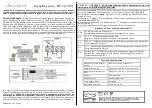
Software User Manual
D-Link Unified Access System
12/10/09
Document
34CSFP6XXUWS-SWUM100-D7
Monitoring and Managing Intrusion Detection
Page 491
Viewing Access Point Triangulation Status
Triangulation information is provided to help locate the rogue client by showing which managed APs detect the each device
discovered through the RF Scan. Up to six triangulation entries are reported for each AP detected through the RF Scan:
three entries by non-sentry APs and three entries by sentry APs. Since an AP may have one radio configured in sentry mode
and another radio configured in non-sentry mode, the same AP can appear in both lists. If the AP has not been detected by
three APs, then the list may contain zero, one or two entries.
Table 314: Detailed Access Point RF Scan Status
Field
Description
MAC Address
The Ethernet MAC address of the detected AP. This could be a physical radio interface or VAP
MAC. For D-Link APs this is always a VAP MAC address.
SSID
Service Set ID of the network, which is broadcast in the detected beacon frame.
Channel
Transmit channel of the AP.
Status
Indicates the managed status of the AP, whether this is a valid AP known to the switch or a
Rogue on the network. The valid values are:
•
Managed: The neighbor AP is managed by the wireless system.
•
Standalone: The AP is managed in standalone mode and configured as a valid AP entry
(local or RADIUS).
•
Rogue: The AP is classified as a threat by one of the threat detection algorithms.
•
Unknown: The AP is detected in the network but is not classified as a threat by the threat
detection algorithms.
Initial Status
If the AP is not rogue, the initial status is equal to Status (Managed, Standalone, or Unknown).
For rogue APs, the initial status is the classification prior to this AP becoming rogue.
Transmit Rate
Indicates the rate at which the AP is currently transmitting data.
WIDS Rogue AP
Mitigation
Status indicating whether rogue AP mitigation is in progress for this AP. If mitigation is not in
progress then this field displays the reason, which can be one of the following:
•
Not Required (AP s not rogue)
•
Already mitigating too many APs.
•
AP Is operating on an illegal channel.
•
AP is spoofing valid managed AP MAC address.
•
AP is Ad hoc.
Age
Time since this AP was last detected in an RF scan.
Discovered Age
Time since this AP was first detected in an RF scan.
BSSID
Basic Service Set Identifier advertised by the AP in the beacon frames.
Physical Mode
Indicates the 802.11 mode being used on the AP.
Security Mode
Security mode used by the AP.
802.11n Mode
Indicates whether this AP supports IEEE 802.11n mode.
Beacon Interval
Beacon interval for the neighbor AP network.
Highest Supported Rate
Highest supported rate advertised by this AP in the beacon frames. The rate is represented in
increments of 1 Mbps.
Peer Managed AP
Indicates whether this AP is managed by a switch in the cluster.
Ad hoc Network
Indicates whether the beacon frame was received from an ad hoc network.
OUI Description
Identifies the manufacturer of the AP or wireless client adapter based on the information in the
OUI database on the switch.
















































